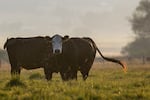Wildfires in Oregon have burned a record-breaking swath of land this season – much of it in Eastern Oregon. Those fires have also scorched miles of fencing that kept livestock on the pasture. And replacing that fencing can be expensive.
“And then you also have to consider how long it takes. It will take years to build that fencing,” said Herb Winters, Gilliam County Soil and Water Conservation District manager.

Cows roam a field along Highway 30, just south of Baker City, Ore., in this July 30, 2024 file photo. Thousands of acres of grazing land went up in smoke this summer's wildfire season, and so did a lot of fencing that's time-consuming and costly to replace.
Anna Lueck / OPB
To remedy that, the district is trying something different — virtual fencing. The conservation agency secured about $275,000 from local ranchers and government funds to install a set of reception towers and put GPS-enabled collars on cows. That will allow four ranchers participating in the pilot project to control where their cattle can graze.
When the cow gets near the edge of the fence, it receives an audible warning. If the cow proceeds to cross the boundary, it receives a short benign shock — similar to an electric dog fence.
The project could save a lot of time and money. In Gilliam County this summer, the Lone Rock Fire burned some 50,000 acres and it extended into Morrow County, much of it land where ranchers graze their cattle. Winters said his office figured the fire destroyed over 300 miles of fencing, which is estimated to cost about $9.5 million to replace.
Winters said the goal, at least in the short term, is to allow cattle to graze on other range grounds while the burned areas recover – usually it takes up to two years.
But in the long-term, he said there’s a laundry list of benefits, like moving cattle away from areas that have been reseeded or treated for invasive grasses — which can make wildfires worse because they dry out earlier in the growing season and grow faster than native perennial grasses.
Virtual fencing has been around for decades, but in recent years it’s become more cost effective. Another project, in Wallowa County, is testing how virtual fencing can protect a community forest that supports grazing, recreation and sensitive plant species.
It can allow ranchers to rotate cattle more efficiently so that they don’t overgraze an area and can help wildlife navigate grasslands more easily. And ranchers can direct their herds to munch away an area to create a fire break, said Winters.
“We’ve seen this technology as being a valuable tool, and trying to get folks to adopt a new technology like this can be difficult,” he said. “It’ll help the ecology of the range land. And it can help protect against future wildfire events with the mitigation practices that can be used.”
Roger Lathrop, a project manager at the conservation district, said the idea is to introduce ranchers to the technology with the hope that other producers see it and adopt it in the future.
“We’re helping them, but we’re also allowing them to try this tech technology at a pretty minimal cost, instead of them having to deal with all the effects of wildfire, repairing fences, buying hay or finding new pastures,” Lathrop said.


